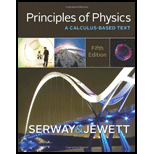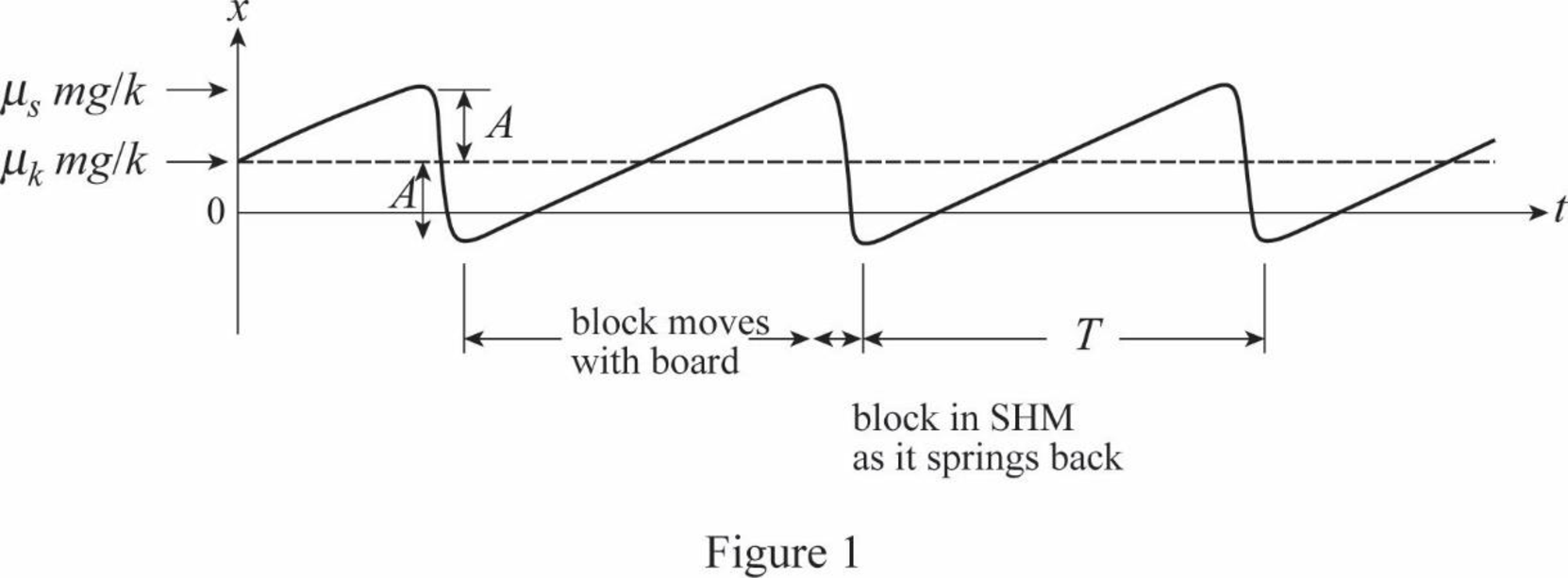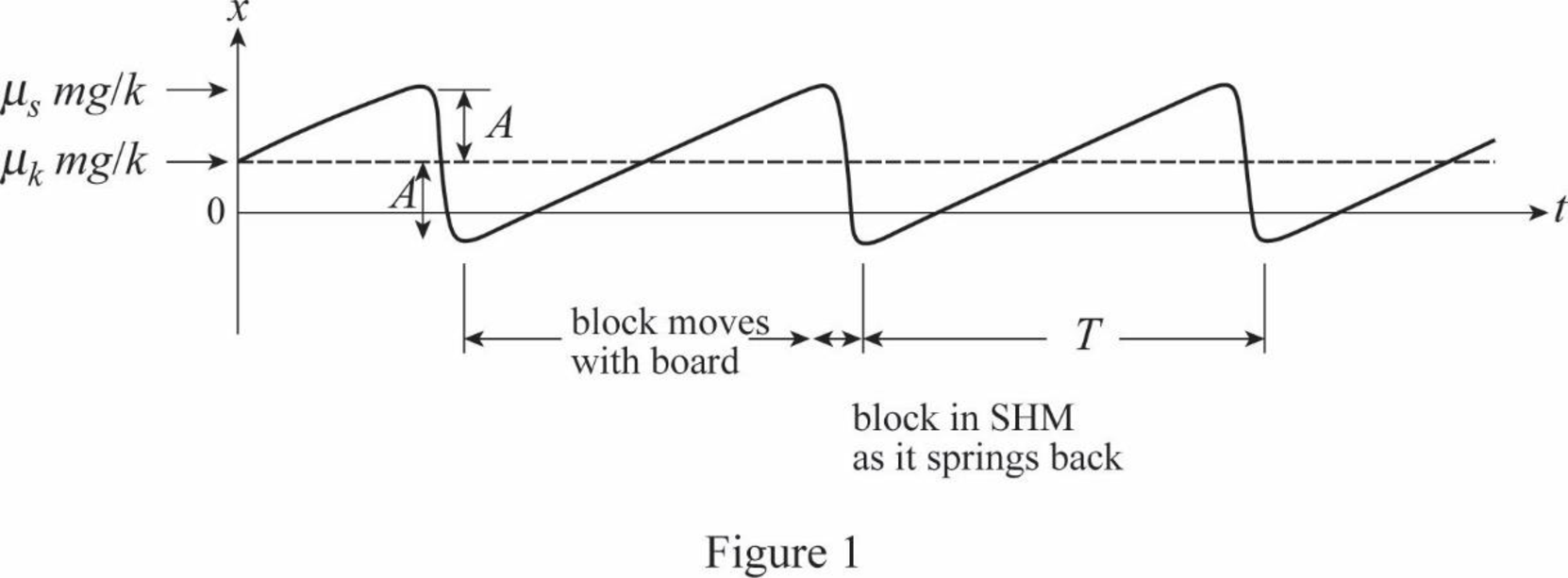
Concept explainers
(a)
Prove that the maximum stretching of spring from mean position is
(a)
Answer to Problem 60P
It is proved that the maximum stretching of spring from mean position is
Explanation of Solution
Write the relation between force on spring and maximum static frictional force.
Here,
Write the expression for
Here,
Rewrite the first equation by substituting the above one.
Conclusion:
Rewrite the expression for
Therefore, it is proved that the maximum stretching of spring from mean position is
(b)
Prove that block oscillates about mean point when spring is stretched by
(b)
Answer to Problem 60P
It is proved that block oscillates about mean point when spring is stretched by
Explanation of Solution
The block will be almost at rest at the break point because of the smaller value of velocity. The block starts to oscillate s soon when the force on block becomes
Here,
Rewrite the above equation by multiplying and dividing the second term with
Express the term
Here,
Rewrite the expression for
Conclusion:
From the above calculation, it is evident that block starts to be in simple harmonic motion about mean position on displacing the spring
Therefore, it is proved that block oscillates about mean point when spring is stretched by
(c)
Plot the variation of position of block with time.
(c)
Answer to Problem 60P
The plot is

Explanation of Solution
The graph is plotted with time on x-axis and position on y-axis.

The dotted line along x-axis denotes the function
Conclusion:
Therefore, the graph is plotted
(d)
Prove that the amplitude of oscillation is
(d)
Answer to Problem 60P
It is proved that the amplitude of oscillation is
Explanation of Solution
Write the expression for
Rewrite the above expression by substituting
Amplitude is the maximum displacement from the mean position only. Rewrite the expression as amplitude.
Here,
On pulling the block to distance
Conclusion:
Therefore, it is proved that the amplitude of oscillation is
(e)
Prove that the period of oscillation is
(e)
Answer to Problem 60P
It is proved that the period of oscillation is
Explanation of Solution
Write the expression for time taken by block to move with the board
Here,
Rewrite the expression by substituting
Time taken by block to move from mean position to an extreme position.
Here,
The period of oscillation is the sum of
Here,
Conclusion:
Rewrite the above equation by substituting the relations for
Therefore, It is proved that the period of oscillation is
Want to see more full solutions like this?
Chapter 12 Solutions
Bundle: Principles of Physics: A Calculus-Based Text, 5th + WebAssign Printed Access Card for Serway/Jewett's Principles of Physics: A Calculus-Based Text, 5th Edition, Multi-Term
- A capacitor with a capacitance of C = 5.95×10−5 F is charged by connecting it to a 12.5 −V battery. The capacitor is then disconnected from the battery and connected across an inductor with an inductance of L = 1.55 H . At the time 2.35×10−2 s after the connection to the inductor is made, what is the current in the inductor? At that time, how much electrical energy is stored in the inductor?arrow_forwardCan someone help me with this question. Thanks.arrow_forwardCan someone help me with this question. Thanks.arrow_forward
 Physics for Scientists and Engineers: Foundations...PhysicsISBN:9781133939146Author:Katz, Debora M.Publisher:Cengage Learning
Physics for Scientists and Engineers: Foundations...PhysicsISBN:9781133939146Author:Katz, Debora M.Publisher:Cengage Learning Principles of Physics: A Calculus-Based TextPhysicsISBN:9781133104261Author:Raymond A. Serway, John W. JewettPublisher:Cengage Learning
Principles of Physics: A Calculus-Based TextPhysicsISBN:9781133104261Author:Raymond A. Serway, John W. JewettPublisher:Cengage Learning Physics for Scientists and Engineers, Technology ...PhysicsISBN:9781305116399Author:Raymond A. Serway, John W. JewettPublisher:Cengage Learning
Physics for Scientists and Engineers, Technology ...PhysicsISBN:9781305116399Author:Raymond A. Serway, John W. JewettPublisher:Cengage Learning Classical Dynamics of Particles and SystemsPhysicsISBN:9780534408961Author:Stephen T. Thornton, Jerry B. MarionPublisher:Cengage Learning
Classical Dynamics of Particles and SystemsPhysicsISBN:9780534408961Author:Stephen T. Thornton, Jerry B. MarionPublisher:Cengage Learning Physics for Scientists and EngineersPhysicsISBN:9781337553278Author:Raymond A. Serway, John W. JewettPublisher:Cengage Learning
Physics for Scientists and EngineersPhysicsISBN:9781337553278Author:Raymond A. Serway, John W. JewettPublisher:Cengage Learning Physics for Scientists and Engineers with Modern ...PhysicsISBN:9781337553292Author:Raymond A. Serway, John W. JewettPublisher:Cengage Learning
Physics for Scientists and Engineers with Modern ...PhysicsISBN:9781337553292Author:Raymond A. Serway, John W. JewettPublisher:Cengage Learning





